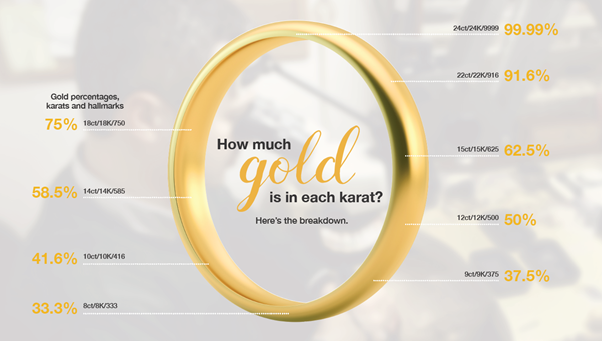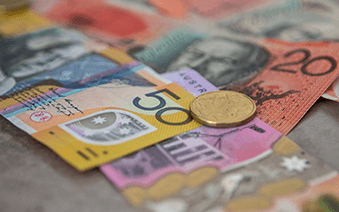Are you curious about the world of buying and selling gold? There’s a bit to know first.
Understanding the basics can help you make sure that what you buy is the real deal.
There are many different types of gold out there, which is what makes the process a little tricky. That’s where we come in.
| Table of contents |
|---|
You might not know anything about gold but you’ve probably heard about carats.
Carats or Karats (pronounced ‘carrots’) refers to the amount of gold used to make a piece of jewellery.
Natural gold is soft, which is why gold items are often mixed with other materials to make it stronger.
Because of this, people look for jewellery with the highest amount of gold. Basically, the higher the amount of gold, the more valuable the item will be.
Carat purity is expressed in units of 24, which means that 100% equals 24 carat, 50% equals 12 carat, and so on. Bruno Mars was not wrong about his 24K magic in the air.
Gold jewellery is generally between 9 and 22 carats, but you might come across the purest 99 percentile – gold that’s worth the most at 24ct. So how do you find out how much gold is in an item?
The best way to check the carat of a gold item is to check for a hallmark stamp with a number value, accompanied by a K or ct. These hallmark stamps represent the percentage of gold in the piece.

Pure gold is valuable but it’s not very good at holding its own shape or anything else that’s of value on it, like diamonds.
Gold alloy is when jewellers mix the gold with other hard metals – most commonly silver, copper and zinc – to give it strength and durability. This is how you get gold jewellery.
There’s no doubt that colour can throw us off. For some items, colour can determine the value of something.
You might be surprised at how many gold colour variations there are. Aside from the well-known yellow, white and rose, there's also red, bronze, lime and even purple and blue gold alloys. Copper gives it a pink hue, while white gold usually involves a combination of nickel, palladium and manganese.
The gold price is determined by the percentage and weight of actual gold used.
White gold is quite expensive because it’s plated with rhodium, a very costly precious metal, added to maintain the brilliance of white gold.
Platinum jewellery is more expensive than gold jewellery, but the spot value of the metal is less than gold.
So why is platinum jewellery more expensive? Mostly because platinum is more brittle than gold and is used as a higher percentage alloy.
An 18ct gold ring still only has 75 per cent pure gold, while most platinum alloys are as high as 95 per cent platinum.
Yes, absolutely. There are so many factors that affect its value in the market, like the economy and higher demand as gold mining declines, but it remains strong.
When you think about gold, you think; class, elegance, treasure – a physical commodity that’s getting harder to find.
Not exactly.
Although it’s great to keep track and monitor the changing price of gold, selling it is a different story. The value of your piece determines the price you can sell it for.
How to sell gold at the best price for you is determined through the weight, purity, and content of your item. After that, a vendor may quote you differently based on how easy it is for them to extract the gold, taking into consideration the labour costs to do so.
If you’re not sure where to start, you can get a quote from Cashies for the value of your gold. Our experienced team can help you sell your gold for the best price.
You can easily find gold from the comfort of your own home. The safest bet on getting pure gold is from a reputable Australian retailer.
We recommend calling any retailer that you’ve found from a quick Google search and ask them any questions you may have.
If you’re thinking of buying pre-loved gold jewellery, our team is always here to help you with any questions you might have about our gold items on offer. You can even browse bullions and gold coins on our webshop.
Otherwise, if you’re looking to trade-in some gold lying around the house or you’re unsure how to sell gold at the best price, we can help with that too.
By now, you should have a rough idea of what quality gold jewellery looks like.
Here are a few things to remember when you’re buying:
Purpose for your gold jewellery
Is it a statement piece for you to wear? Are you collecting it to keep somewhere safe ? Gold is soft and has a hard time holding its shape, so sometimes the purest gold can’t withstand harsh environments.
People who want to wear it every day generally aim for low-carat jewellery with a stronger alloy to help it last the distance.
Is it gold-filled or gold plated?
Gotcha! Yes, there are two ways of making your gold.
If you’ve ever walked into those budget-friendly jewellery stores at the shops – you know the ones – you’ll notice gold jewellery for sale that’s ‘goldplated’.
This means they’re made of non-gold base metals that are then dipped into molten gold to create a golden coat on the surface. It’s cheaper than gold-filled jewellery.
Go to a reputable vendor
Find a trusted jeweller or gold vendor to make sure you’re looked after.
In Australia, there are plenty of vendors online you can find that can help you identify quality gold or even help you sell it. If you’re still wary, ask for certificates and credentials to fact-check them.
Know your carats, alloys, and hallmarks
These are the three key factors in identifying the quality of the gold you’re looking at.
Don’t forget, the value of any item you want to sell can fall if you don’t take care of it while it’s yours. That’s why you should make a habit of looking after your pieces so they retain their quality.
Regularly clean and store your gold pieces at room temperature out of direct sunlight, preferably somewhere with soft lining. Low humidity does the trick and helps to prevent tarnishing and discolouration.
Got it? Good. If you follow this guide, you should be able to spot all the right things when it comes to buying and selling gold for the best price.

Answering your questions about loans and staying savvy

Get more bang for your buck with these handy tips.

Need some advice that’s not about cash? We can help.